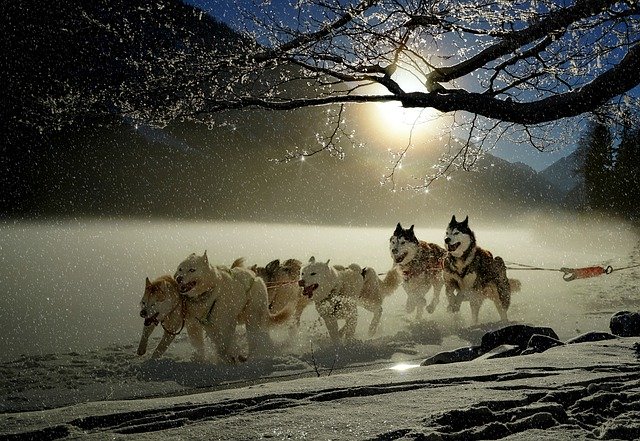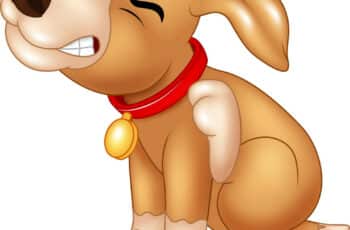What makes Iditarod dogs so tough and able to compete in such a demanding race environment? Racing is a sport to compete for the fastest racer who can cross a specific distance.

Tough Team Ready For The Race
The races can take as short as less than a minute or as long as several days. It is a test of speed and endurance. It takes a special kind of athlete to compete in racing, whether man or dog.
Humans are not the only ones who compete in racing. When racing dogs become involved, the sport is called Mushing. Mushing can also refer to basic transportation with the use of dogs. A sled can be towed on snow, or if it is dry, a rig will be towed.
The Iditarod Trail
When it comes to sports, ‘The Last Great Race: The Iditarod Trail Race’ is the most well-known mushing in Alaska, United States. The mushers, with their team of dogs, travel from Anchorage to Nome in harsh, cold weather. This grueling race takes eight to fifteen days or more to finish in the harshest of weather imaginable.
The route that the mushers and dogs go through has “jagged mountain ranges, frozen river, desolate tundra, and miles of the windswept coast,” according to the Iditarod Trail Committee.
When you consider the blizzards and the temperature that goes sub-zero, it makes you wonder how anyone completes the race at all. So, just what makes Iditarod dogs so tough?
So how come these dogs are so strong?
Each team of dogs is a pack and their pack leader is their musher. It falls on the mushers to select, build, and train his team of dogs for the race. Every musher has a different belief, personality, and strategy for raising their dogs to become healthy and sturdy.
These mushers are not totally different from each other, though. They certainly have minor, individual differences. However, what they all have in common is their ultimate goal. And, to reach that goal, they all train their dogs to be in the best condition for mushing.
The muscle training regimen that endures
When we humans do moderate to extreme exercise, our muscle tissues get damaged. It then gets repaired and becomes stronger, depending upon what we eat. This can be in the form of high protein or carbohydrates.
The building of muscles involves a lot of time. This is because every time we exercise, our muscles undergo another cycle of damage and repair. But when it comes to racing dogs who experience extreme training every day, this is a different story.
Dogs appear to adapt to the training more quickly than humans. Further, muscle development and the stress of training combine to build increased stamina. Obviously, a high level of stamina is needed to survive the long trek of the Iditarod Trail.
Calorie intake
As a rule of thumb for keeping dogs healthy, dogs should eat food that balances the energy they spend. In the case of Iditarod dogs, they eat more than the average backyard dog, to say the least.
To survive the journey of the race, the dogs are fed about 12,000 calories of dog food a day. The dog food must be calorie-dense for these dogs to be fed enough without getting sick. Balancing the safe volume of food with the number of calories required to supply their muscles takes some consideration, for sure.
Mushers take great care of their dogs. And, in turn, their team of dogs will take them to the finish line. Training may be harsh. The surrounding condition is certainly cruel. However, to survive the Iditarod, man and dog must be toughened up.

Tough Dog Team In The Snow
Other factors important to building a dog racing team:
When building a racing team, especially for a race as tough and demanding as the Iditarod, there is a logic to the plan. The mushers may belong to a kennel that has more than one team in training at a time. The trainers must select dogs to balance out the rest of the team. This usually means giving consideration to the following details.
- Age of dogs is important. Adult dogs, often under 16 months old.
- Sex of dogs must be considered. Usually with a fairly well-balanced ratio of male to female dogs on a team.
- Dogs that can be flexible as to position on the team are highly desirable.
- Personality of the dogs is critical. They need to be able to get along with the rest of the team.
- Gait is considered when pairing up dogs as well. Trotters and lopers should not be paired as they cannot pull smoothly together.
- Size of dogs is also an issue. Pairing a very large dog with one much smaller causes several problems best avoided.
- Pace at which a dog eats. You do not want the faster eating dog “wolfing down” his food and then stealing his partner’s nutrition.
In Summary
As you can see, many factors go into selecting a dog racing team. It is even more complicated when you add in the factors responsible for what makes Iditarod dogs so tough.
Photos courtesy of Pixabay

Tough Team Ready For The Race



